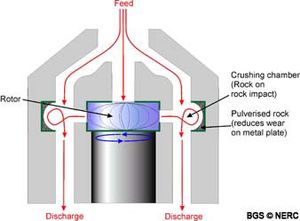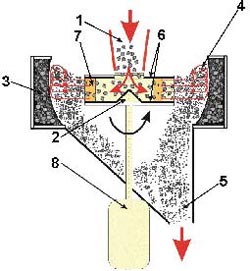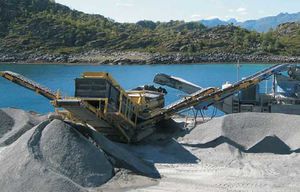Difference between revisions of "Vertical Shaft Impact Crushers"
| Line 7: | Line 7: | ||
* Please start editing this page after the /noinclude | * Please start editing this page after the /noinclude | ||
* -------------------------------------------------></noinclude> | * -------------------------------------------------></noinclude> | ||
[[File:VSI-Crusher_principle.jpg | thumb | right | Vertical Shaft Impactor ]] | |||
[[File:VSI_Crusher_principe.jpg | thumb | right | Vertical Shaft Impact Crushers Principe]] | [[File:VSI_Crusher_principe.jpg | thumb | right | Vertical Shaft Impact Crushers Principe]] | ||
[[File:VSI_Crusher_mobile.jpg | thumb | right | Mobile Vertical Shaft Impact Crusher]] | [[File:VSI_Crusher_mobile.jpg | thumb | right | Mobile Vertical Shaft Impact Crusher]] | ||
'''Vertical Shaft Impact'''(VSI) crushers use a different approach involving a high speed rotor with wear resistant tips and a crushing chamber designed to 'throw' the rock against. The VSI crushers utilize velocity rather than surface force as the predominant force to break rock. In its natural state, rock has a jagged and uneven surface. Applying surface force (pressure) results in unpredictable and typically non-cubicle resulting particles. Utilizing velocity rather than surface force allows the breaking force to be applied evenly both across the surface of the rock as well as through the mass of the rock. Rock, regardless of size, has natural fissures (faults) throughout its structure. As rock is 'thrown' by a VSI Rotor against a solid anvil, it fractures and breaks along these fissures. Final particle size can be controlled by | '''Vertical Shaft Impact'''(also called 'VSI Impactors') crushers use a different approach involving a high speed rotor with wear resistant tips and a crushing chamber designed to 'throw' the rock against. The VSI crushers utilize velocity rather than surface force as the predominant force to break rock. In its natural state, rock has a jagged and uneven surface. Applying surface force (pressure) results in unpredictable and typically non-cubicle resulting particles. Utilizing velocity rather than surface force allows the breaking force to be applied evenly both across the surface of the rock as well as through the mass of the rock. Rock, regardless of size, has natural fissures (faults) throughout its structure. As rock is 'thrown' by a VSI Rotor against a solid anvil, it fractures and breaks along these fissures. Final particle size can be controlled by | ||
Revision as of 03:18, 1 February 2012
Vertical Shaft Impact(also called 'VSI Impactors') crushers use a different approach involving a high speed rotor with wear resistant tips and a crushing chamber designed to 'throw' the rock against. The VSI crushers utilize velocity rather than surface force as the predominant force to break rock. In its natural state, rock has a jagged and uneven surface. Applying surface force (pressure) results in unpredictable and typically non-cubicle resulting particles. Utilizing velocity rather than surface force allows the breaking force to be applied evenly both across the surface of the rock as well as through the mass of the rock. Rock, regardless of size, has natural fissures (faults) throughout its structure. As rock is 'thrown' by a VSI Rotor against a solid anvil, it fractures and breaks along these fissures. Final particle size can be controlled by
- the velocity at which the rock is thrown against the anvil and
- the distance between the end of the rotor and the impact point on the anvil.
The product resulting from VSI Crushing is generally of a consistent cubicle shape such as that required by modern SUPERPAVE highway asphalt applications. Using this method also allows materials with much higher abrasiveness to be crushed than is capable with an HSI and most other crushing methods.
VSI crushers generally utilize a high speed spinning rotor at the center of the crushing chamber and an outer impact surface of either abrasive resistant metal anvils or crushed rock. Utilizing cast metal surfaces 'anvils' is traditionally referred to as a "Shoe and Anvil VSI". Utilizing crushed rock on the outer walls of the crusher for new rock to be crushed against is traditionally referred to as "rock on rock VSI". VSI crushers can be used in static plant set-up or in mobile tracked equipment.


